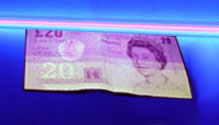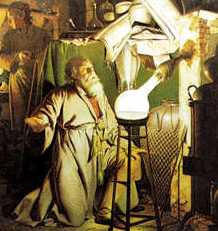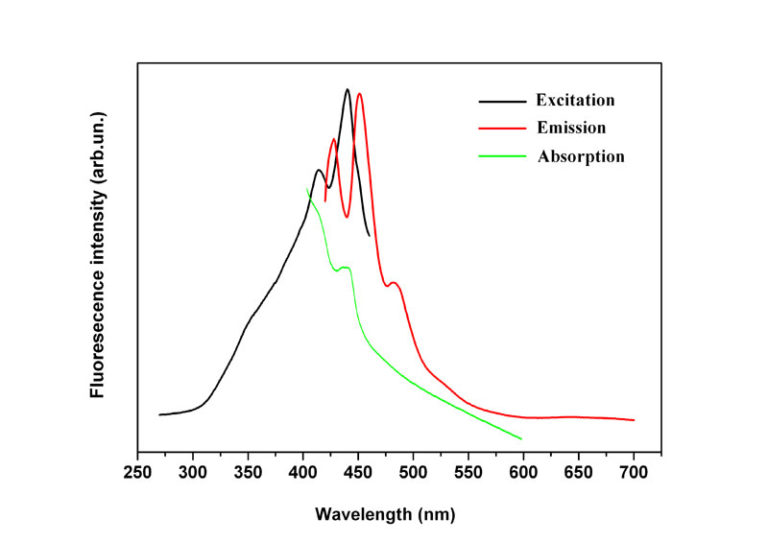Blue Dominican Amber Information
Why is it blue?
By Alec Corday
The short answer would be that the polycyclic aromatic hydrocarbons, produced through a thermal polymerization process initiated via irradiation, relax to their ground state, absorb high-energy ultraviolet photons and re-emit them as lower-energy visible photons, according to the absorbance curve of the particular fluorophore.
Read it again, maybe it will make more sense.
For the rest of us who just judiciously nodded their heads in awe at the deep words above, but truly in their hearts know that they understood diddly-squat (you know who you are), let’s try this again.
First, what is the overall difference between Blue Dominican Amber and Ordinary Amber?
Besides being blue, silly.

Two necklaces. This picture was taken in a dim room on a black background with a fluorescent lamp to the right (so the photographer could see something) and a small UV lamp above the subjects at a 2 second exposure.
For one there fact that it turns blue in sunlight and several other light sources. Then there is the is the lack of fossils. And that it is one of the few natural materials that glow when you’re out clubbing. The term that comes to mind in this regard is fluorescence.
Shiny!
Fluorescence is the thing that turns your white shirts bright blue in the dance club.
White shirts are made white with optical brighteners, which are dyes that suck up the invisible ultraviolet light and bounce it back as visible light. These dyes are used in pretty much everything that has to be a bright color, but it is more commonly used for anything white, including ordinary paper and even toilet paper (don’t ask me what the point is in that).

Not, however, in money. Real money is not supposed to glow blue except in designated areas.
Most of these dyes are synthesized from plants. Plants, as we all know since first grade, are photosensitive. It is possible to derive certain elements from them that are fluorescent, such as stilbene and umbelliferone.
There are many uses for chemicals that make things bright and shiny. Umbelliferone for example is synthesized from coriander and even carrots and besides serving as a dye it is also used in sunscreen lotions. Stilbene is even used in laundry detergents — not to make your clothes cleaner or softer, but to dye them brighter. Kind of cheating, isn’t it?
Yes, but how exactly does the dye do it? How do these ‘fluorescent elements’ become all bright and shiny? And how is this relevant to Amber?
Glowy, shiny things are everywhere nowadays. Watches, lamps, LCD screens, laptops, and even your iPod have some form of glow chemicals involved. Let’s turn to what is probably the most famous fluorescent light in our households: the common fluorescent tube. It’s cheap, it’s efficient and it makes us all uglier (seriously — it’s the worst kind of mirror-lighting around).

What’s In The Tube?
Inside the glass tube is a partial vacuum and a tiny amount of mercury. An electric discharge causes the mercury to emit invisible ultraviolet light (which is actually harmful to living organisms — I’m just sayin’). The tube is powdered with a coating of phosphor – the fluorescent element.
Phosphor can be made out of many materials such as zinc, aluminum, oxides, to name a few, but the first discovery of it was in 1669 by German alchemist Henning Brand when he boiled down 5,500 liters of urine and it started to glow (beer was already popular, so…).
He was trying to produce silver — yes, out of urine — but what he got was a glow-in-the-dark element similar to the one we use today in lamps (that’s right: all CSI fans know that urine glows in the dark).
The process in Blue Dominican Amber is surprisingly similar to phosphor (except no beer involved). The difference between fluorescence and phosphorescence is basically only the amount of time that the glowing element glows.
Let There Be Light !
In order to understand the fluorescent effect in phosphor, Blue Dominican Amber or the above optical brighteners, we have to understand light.
The truth is we don’t know what light is.
We have neat little theories working on the problem, for theories rush in where Angels fear to tread. Yet the only thing scientists agree about is that we probably don’t know the half of it and that our theories are but superficial explanations for a process so complex we might burn up a few hundred grants before ever figuring it out.
So what about them light particles we hear so much about?
We know that there is probably a form of energy that is released by atoms when the electrons that orbit them get excited.
What about?
Good question. It seems that electrons are just tickled pink when something passes energy to their atom ultraviolet particles for example and they jump to a higher orbit around their atom and back down, getting rid of that extra energy along the way (for a better explanation involving a scandalous incident at a wedding, see below).

The ladies in the silly pink dresses start to giggle and jump, their oversized ribbons going bounce-bounce. The bride chucks and one lucky bridesmaid snatches the bouquet and, all excited, steps out of the group to show off her catch.
Now imagine said bridesmaid happens to spot another fellow attendee in this very moment, and it just so happens to be a guy who once upon a time broke her heart. She sees her chance. She throws the bouquet. It knocks the naughty boy out cold. Satisfied the bridesmaid returns to her circle of friends.
What just happened?
The bridesmaid, our electron, took the bouquet, the invisible light particle, bounced to a higher orbit outside of her usual circle and transformed the light particle into a different particle as she bounced back – in this case a formidable weapon against heartbreakers. In this simple example we learn that some atoms (or rather the electrons circling these atoms) transform one type of energy into another type. And that one should never break a girl’s heart, lest one be impaled by a bouquet. Blue Amber
Let’s tally up what we know so far.
Certain natural elements (plants, etc) have molecules whose atoms suck up invisible light and make it visible.
The connection is there. Fluorescence occurs naturally and Amber as we know it is also plant derived, so to speak. Would this then mean that the Amber trees contained elements that were fluorescent?
Looks that way.
At least Blue Dominican Amber. Under a banker’s UV light Dominican Amber becomes a light milky blue — Baltic Amber doesn’t get that shade (one interesting way to keep them apart, to see whether it is true Dominican or just regular Baltic amber).
However, “Blue Amber” is the only Amber that is fluorescent even under daylight. So the fluorescent molecules in Blue Amber are of a higher saturation than in Ordinary Amber.
How on earth did they get there? Again, we don’t know for sure.
But — you guessed it — we got a neat little theory on that.
Anthracene/Perylene Hypothesis
Blue Dominican Amber through Fire

Let’s remember where Amber comes from: trees. The resin becomes Amber, but what becomes of the rest of the organic material from that tree? It undergoes a similar process as Amber and becomes Coal.
Which is why people digging for coal often find Amber, and people digging for Amber often find coal.
We know that from the incomplete combustion of coal and wood and pretty much any other sort of fire, we can get polycyclic aromatic hydrocarbons. Benzo(ghi)perylene i.e. is present as a component of polycyclic aromatic hydrocarbons (PAH) content in the environment usually resulting from the incomplete combustion or pyrolysis of organic matters.
(Although Blue Dominican Amber, when polished, smells different than Ordinary Amber, the term ‘aromatic’ may be misleading: in this case it has nothing to do with odor, referring instead to the hydrocarbon’s chemical properties.)
Another well known hydrocarbon that is fluorescent is anthracene. It is used in the artificial production of dye, wood preservatives, insecticides, and coating materials and rats don’t like it. It is entirely colorless but glows blue under ultraviolet light, and if the anthracene contains traces of naphtacene, then the fluorescent glow may be more green than blue.
So are there anthracene or perylene in Blue Dominican Amber?
The magic words from above are ‘incomplete combustion,’ meaning it takes a fire to produce these fluorescent molecules. Previously we have established that Blue Amber may be the result of a fire, giving possible ash residue as evidence.
And where there’s fire, there’s anthracene and/or perylene.
However, recent studies by Vittorio Bellania and Enrico Giulotto at the University of Pavia, Italy paint a clearer picture. They studied several amber specimensvia means of optical absorption, fluorescence spectroscopy, and time-resolved fluorescence measurements. The resulting spectral analysis revealed that the spectra of the hydrocarbons are very similar in shape to those of diluted solutions of anthracene, perylene, and tetracene. Their emission occurs nearly exactly in the same spectral range of blue amber, indicating that the fluorecent hydrocarbon responsible for the blueness is most likely perylene.
Professor Dr. Tong Tang of the H.K. Baptist University Kowloon, Hong Kong, S.A.R. came to similar results in recent tests. See Dr. Tangs Fluorescence Data Curve below.

Wow! Fascinating, isn’t it? No? Having trouble with this scientific gibberish? Then let’s be practical: take one of our beautiful Blue Dominician Amber pieces and go clubbing, or simply step into the sun if you please…
This should proof the beauty of Blue Dominican Amber without doubt.
Q.E.D.